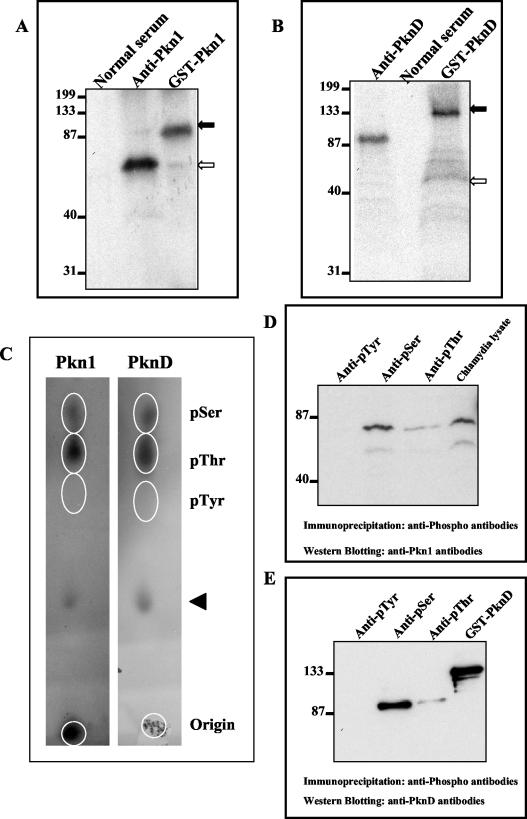FIG. 5.
Phosphorylation of native chlamydial-derived Pkn1 and PknD and phosphoamino acid analysis. Chlamydia-derived Pkn1 and PknD kinase proteins were immunoprecipitated from chlamydial lysates using anti-Pkn1 and anti-PknD antibodies. Immunocomplex-bound beads were directly used for in vitro kinase assay using [γ-32P]ATP. Reactions were electrophoresed, transferred onto membranes, and subjected to autoradiography. Immunoprecipitation of chlamydial lysates by normal rabbit serum was used as a negative control. (A and B) The kinase assaywith purified GST-Pkn1 or GST-PknD was used as a positive control. Solid arrows represent phosphorylated GST-Pkn1 and GST-PknD, whereas open arrows represent phosphorylated Pkn1 (panel A) and PknD (panel B). Positions of molecular mass markers (in kilodaltons) in each panel are indicated on the left. (C) Phosphoamino acid analysis of GST-Pkn1 and GST-PknD by thin-layer chromatography. γ-32P-labeled Pkn1 and PknD proteins after an in vitro kinase reaction were electroblotted, excised, and acid hydrolyzed. Hydrolyzed labeled amino acids were spotted along with marker pSer, pThr, and pTyr amino acids on cellulose thin-layer chromatography plates and separated at high voltage. Marker phosphoamino acids were detected by ninhydrin staining, whereas labeled phosphoamino acids were detected by autoradiography. Spots of the labeled amino acids are encircled in each panel. The arrowhead represents unhydrolyzed proteins. (D and E) Immunoprecipitations from Chlamydia-infected cell lysates were performed using anti-pSer, anti-pThr, or anti-pTyr antibodies. Phosphoimmunocomplexes were separated on SDS-PAGE and transferred to membranes. Western analysis of blots was performed using anti-Pkn1 and anti-PknD antibodies. Panel D represents immunoblotting with anti-Pkn1 antibodies. Five percent input chlamydial lysate was used as a positive control. Panel E represents immunoblotting with anti-PknD antibodies, and GST-PknD was used as a positive control.

